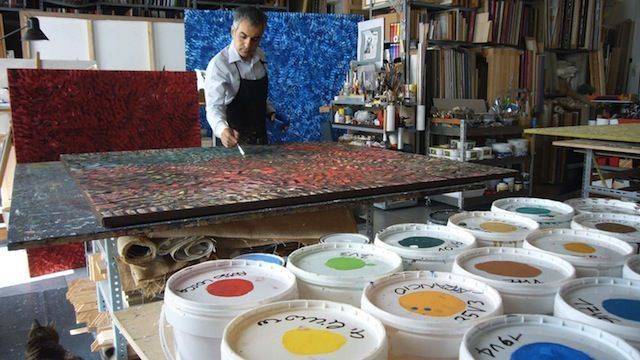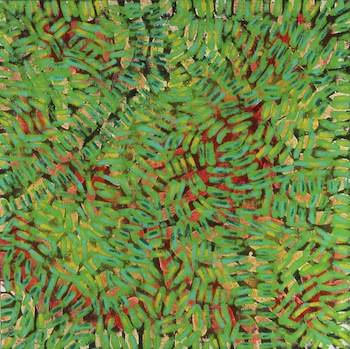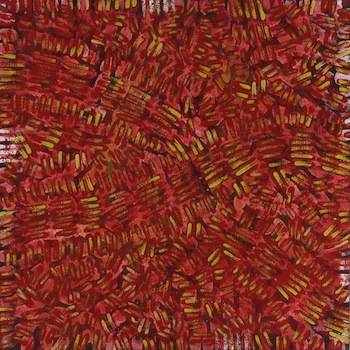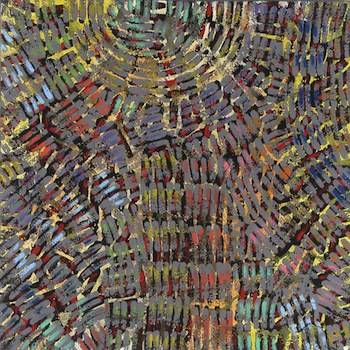On the Path of Abstract Realism
Since his artistic debut, Giorgio Kiaris has always taken a path that differs from the other artists of his generation. A path which has its roots in what was once the cradle of classical art, a process that tends to enhance as much as possible, the space within which ideas develop, a path whose semantic dimension is attributed to the imperceptibility of a mark that it is caught in its early stage of germination, a mark not yet well defined and still unstable. The direction of this path has, of course, been influenced by the cultural environment in which he grew up.
I-Italy had the opportunity to interview the artist before his first New York exhibition. The interview below will introduce you to the life and art of Giorgio Kiaris.
If you were to present yourself to the American public, what would you say about Giorgio Kiaris?
Giorgio Kiaris is an Italian painter with Greek, therefore Mediterranean origins, and with cultural components profoundly linked to the civilizations that created the foundations of classicism. I consider myself a pure painter, who lives his relationship with art as an amanuensis, my interest in the quality of work, does not have a need of technological wizardry and "other" materials…
Moreover, if the environment has a fundamental role in the formation of an artist, in forging the foundation, a role no less important is that of the experiences and encounters, more or less random, with other artists. If an event, whatever it is, can be considered A priori, that is before it happens, a mere possibility, A posteriori must be considered a necessity until each of us occupies the place we currently occupy. It is therefore far from pure chance and initially obscure meaning becomes obvious.
The exhibition in the Big Apple has been planned, desired, or is the result of an opportunity that you could not let pass by?
I would say that nothing ever happens by chance, and that the path of an artist is often a crossroads of meetings that become the seed of ideas. My recent experience has led me to find a partnership, later developed into a friendship, with Alessio Calestani, which proved to be fruitful in many ways, most importantly, to be able to proceed with a youthful and stimulating spirit, allowing me to grow together with the same ideas developed in our dialogue and meetings.
And so, after a long journey throughout Italian cities, which lasted 15 years, which undoubtedly allowed the art of Kiaris to mature, evolve, and be enriched with new elements. Crossing Italian borders, although the art steeps in archaic fragments, the arrival in the new world gives the opportunity for the works to speak another language.
What does it mean for an artist like yourself to have the opportunity to exhibit your works in a gallery of an "artistic window" as that of New York?
I have been to and experienced New York, but just as curious visitor, bringing back in my suitcase of impressions the knowledge that this city's classicism is also due to the continuing evolution and integration ... Now, more than ten years since my first trip, I revisit on an occasion so important... This for me is a great feeling, knowing that I will be under the scrutinous eyes of a public of this certainly unique, one-of-a-kind city. My thoughts can't help but drift to the Big Apple artists who have made it a lasting icon ... how can one not think of unique notes of Gershwin, the stories and novels of James, the vigorous marks of Kline,of Brando and Kazan, Audrey's famous breakfast, or at the latest Manhattan of Allen...
From the colors, the light, through its natural sources, delivery to our senses, the chromatic games that do not have an equal in words but solely in images, in paint marks, which become an expression not only of immediacy but also of the beginning of a rational process that will take pride in its full manifestation, from the subjectivity of experiencing nature in its various manifestations, the eternal movement, the flow of life, to the auspice end of the conflict between "Psyche and Cupid," through the synergy of marks and color. Within these terms, lies the path which led to evolution of the art of Kiaris.
How many and what exhibits have you had the opportunity to present to your audience?
Since 1998, I have held seven personal exhibitions, all in Italy. Each has always presented the cycle of works with which my research from time to time progressed. Listing them is retracing the evolution of my emotions, a sort of an imaginary film... First in 2000, " Refractions," in the province of Parma, in which, affront was the theme of light, the great cycles dedicated to the moon, the sky and water are the subjects that lead to rarefy the color in a thin layer. "The Synchronous" in Cuneo, works characterized by two paintings assembled for a single "synchronic" perception.
In 2006, "For another planet," in Brescia. Networks, works on canvas with overlapping networks of various sizes and textures, in so doing, the color gets harnessed with suggestive and unique color variation. In 2009, "Karte" in the province of Parma, an exhibit of derivative works from musical suggestions and associated literal observation of nature and transposed in big scale. In the same year "A-Mare," in Genoa, where I go through a sort of journey dedicated to the sea, following the track of one of my poems.
In 2012, I presented "Synergies," in Milan, merging the two components of my research, the vectorial and cyclical, where the pain marks, the color and shape develop a cohesion of primary elements.
What is, then, the theme of this exhibit ?
The "Cromografie" are the non-iconic representation, the drafting of the painting , as well as the will to find, beyond the presence of a minimal and tangible objectivity, the thought of infinity.
The sensation that we get when facing Nature such as the ocean, the desert, the great glaciers. These are images that take us back to a primitive stage, where we are totally involved in something greater than ourselves. "The Cromografie," are strongly linked to events, especially "natural" and therefore to feelings that the painting gives us through ecological themes such as the Earth, the Sea, and the seasons. Almost a renewed desire of values often stepped on by progress easily prone to delete everything.
But art is an affirmation of identity or cathartic process, the need to communicate or the resolution of one's finite nature into something imperishable, or perhaps, a surge through which the soul, full of experiences, transforms a feeling into a meaning?
Why do you want to create?
I started painting in 1989, after one of the many trips and stays in Paris, where I met the "Impressionists" and deepened my knowledge of contemporary painting. But above all, I was struck by Monet's Water Lilies. The emotional baggage that travels give me is essential to my research, in addition to literature, poetry, theater, music and cinema. An interdisciplinary knowledge, which does not exclude anything, but instead is enriched whenever we are willing to learn, and makes us aware of discovery. That feeling of primitive simplicity, attributed to the virginity without which every perception would be altered.
Painting with eloquent color variations where the ontology of the strokes refers to the color, and through the development of this, by analogy or by induction or deduction, where the abstract leads immediately to a concrete image.
In which aesthetic form does your work fits best?
The painting is often traced back to the genre figurative or abstract. This way of classifying art, however, is a bit ' generic' and poorly suited to determine which are really the characteristics of its nature. The dualism between figurative and abstract, was recently studied by Gastone Biggi, (whom was my master, and whose assistant I became), he in fact, tends to modify the reading and practicality of art, annulling for the first time the diarchy figurative - abstract, writing in 2005, the manifesto of the abstract-realis . I think that this interpretation is very interesting, especially in these times where almost everything has already been tried, and only a further deepening into our past will give us the boost needed to proceed on a new road.
The paintings of Giorgio Kiaris will be exhibited for the first time in New York at the S. Artspace Gallery, 345 Broome Street. The exhibit, titled "Cromografie" will be open to the public from 9 October 2013 to 31 October 2013, from 6PM to 8PM.









































i-Italy
Facebook
Google+
This work may not be reproduced, in whole or in part, without prior written permission.
Questo lavoro non può essere riprodotto, in tutto o in parte, senza permesso scritto.